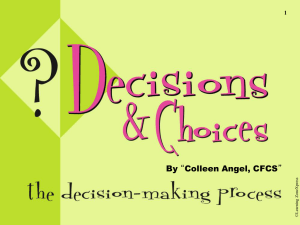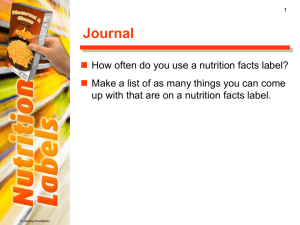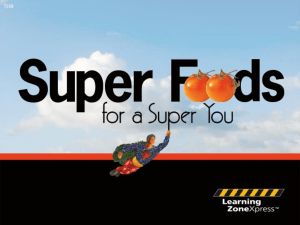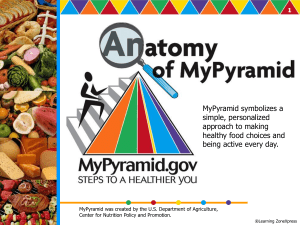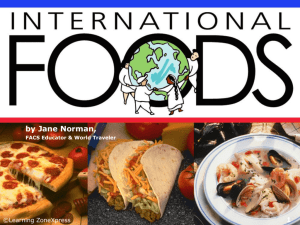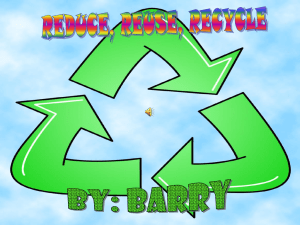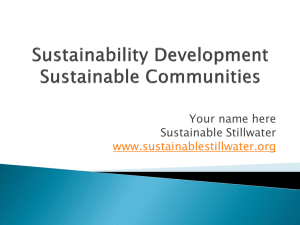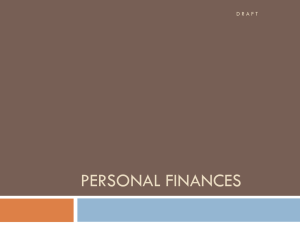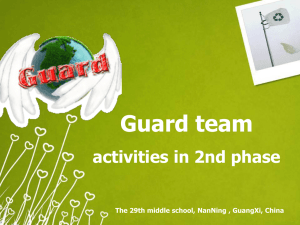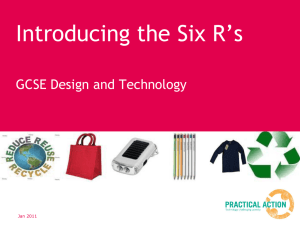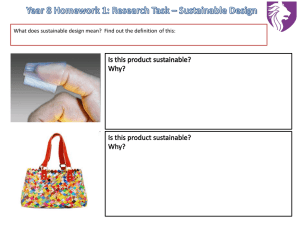Reduce, Reuse, Recycle
advertisement
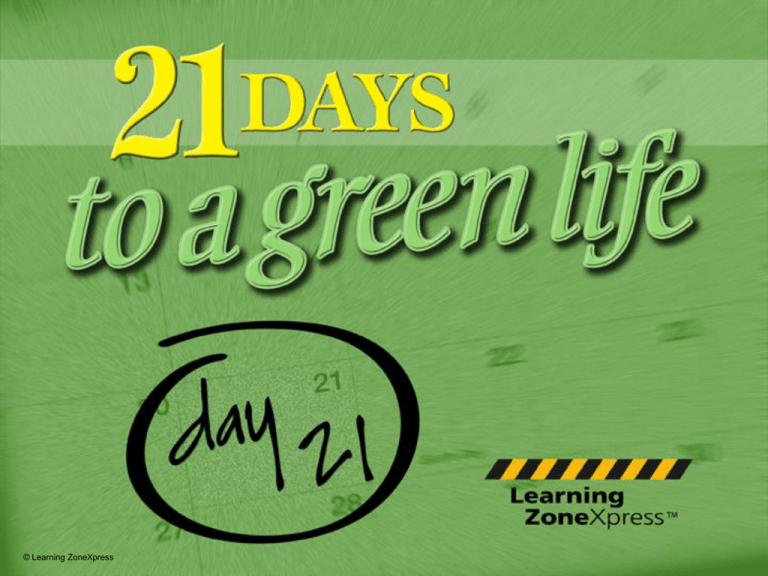
© Learning ZoneXpress © Learning ZoneXpress 1 Why Get on the Green Fast Track? • • • • Safeguard natural resources Cut expenses, cut waste Improve your health Feel good about your contribution 2 © Learning ZoneXpress Get Up to Green Speed • Search the Internet • Check through books • Browse magazine articles • Ask a semi-expert 3 © Learning ZoneXpress Can You Speak the Language? • Sustainability – a way to live in harmony with the environment • Global warming – activities that cause the earth to heat up • Renewable resources – an effort to protect water, food, timber and energy to use again and again. • Reduce, Reuse, Recycle – a plan to create less daily waste 4 © Learning ZoneXpress Flip a Switch to Save Energy • Turn off lights, electronics and appliances • Replace regular light bulbs with CFLs • CFLs use ¼ energy, last 15 times longer • Turn heat down a few degrees • Use fans instead of air conditioning. 5 © Learning ZoneXpress Get Out of Hot Water • Take a quick shower instead of bath • Wash your clothes in cold water • Dishwasher uses less hot water than hand washing • Brush teeth then rinse 6 © Learning ZoneXpress Gauge Your Gas Oil is not a renewable resource • Carpool with friends • Public transportation is a bargain • Hop on your bike • Rediscover your feet 7 © Learning ZoneXpress Solve the Plastic Problem • 500 billion plastic bags are used each year • Family of four uses 15 bags per grocery trip • Plastic bags kill hundreds of thousands of marine animals • Bags made with petroleum substances and toxic chemicals Solution Shop with reusable cloth bags 8 © Learning ZoneXpress Drink to Your Environment • 40 million plastic bottles discarded each day Solutions • Recycle plastic bottles • Tap into tap water • Carry a reusable bottle • Bottle throwaways eyesore and waste • Bottled water costs 10,000 times more than tap 9 © Learning ZoneXpress Save a Tree • Paper takes up one-half of landfill space • Millions of trees cut for mail, paper products • $1 of a $10 purchase goes to packaging Solutions Recycle all paper Pass on books and magazines Use less packaging Opt out of junk mail at www.dmachoice.org/mps 10 © Learning ZoneXpress Visit a Landfill • Nearly 60% of trash buried • 3,500 landfills in United States • 200 million tons of solid waste per year • Costs around $40 a ton to dispose of waste 11 © Learning ZoneXpress Weigh Your Waste • • • • Average person creates 4-5 pounds of daily garbage Save all your trash today Include garbage at home, school, in public Weigh the total at end of day 12 © Learning ZoneXpress Give Biodegradability a Break • Organisms break down biodegrade - products to return to the earth • Some biodegrade quickly, some never How Fast Items Biodegrade • Banana peel – 7 days • Paper – 5 months • Cotton clothing – 5 months • Nylon – 40 years • Aluminum cans – 100 years • Disposable diapers – 500 years • Plastic bottles - never Use a biodegradable product today 13 © Learning ZoneXpress Rev Up to Reduce, Reuse and Recycle Plan to Manage Waste • Reduce trash by using less • Reuse items for a longer life • Recycle discards for new products Check your community for recycle locations 14 © Learning ZoneXpress Eliminate E-Waste • What: computers, TVs, cameras, phones, batteries, music players • Why: contain toxins – lead, mercury, nickel • How: recycle or safe disposal • Where: tech stores, local centers, www.earth911.org 15 © Learning ZoneXpress Give Grooming the Green Light • Consumer uses more than 15 personal care products per day • Less than 1% of care products get safety check • Choose safer personal care products • Look at ingredients. Chemicals? Organic? 16 © Learning ZoneXpress Go Green in Your Closet • Recycle clothes with donations and exchanges • Benefits come with chemicals • Consider natural fibers – organic cotton, hemp, bamboo and corn 17 © Learning ZoneXpress Eat Something Green Today • Organic – USDA Label • Not genetically modified • 95% pesticide free • No hormones • All Natural – Mostly a Farmers’ Markets – Local produce • Fresh, seasonal • Check for organic label slogan – Claims include: • No preservatives • No artificial flavors • No food coloring © Learning ZoneXpress 18 Consider Safety-First Cleaning • Toxins in cleaners can harm people, and the environment - nausea - headaches - rashes - eye irritation - difficulty breathing - liver, kidney problems - cancer • Try new green, non-toxic cleaners • Create natural cleaners with baking soda, vinegar, salt 19 © Learning ZoneXpress How Green Is Your Building? • Building supplies often contain toxic chemicals • Building industry starting to turn green • Organic materials, natural woods and fresh air ventilation offered • Check out organic paints 20 © Learning ZoneXpress Reduce Your Carbon Footprint What’s a carbon footprint? • The amount of carbon dioxide (CO2) emissions you use • Calculate home, energy, travel, shopping, food • Calculators on Internet • Go carbon neutral – • Offset CO2 usage with charitable donations 21 © Learning ZoneXpress Turn Someone Green • Share your discoveries • Explain reduce, reuse, recycle plan • Personal experiences can guide others • A good review for you 22 © Learning ZoneXpress Good Job – Good Beginning • • • • • List your changes Weigh your waste again Are you recycling? Give yourself a green star for a great green start Keep on living green 23 © Learning ZoneXpress What Will You Do in 21 Days? • Journal about your transition to a green life. Each day write a quick note about what you did to support the environment and remember to use recycled paper. 24 © Learning ZoneXpress Review Questions 1. How many plastic bags are used every year? 500 million? 50 billion? 500 billion? 500 billion. 2. What can you do at the grocery store to reduce waste? Bring reusable cloth shopping bags. 3. How can you save energy in your home? Turn off lights and appliances when not in use. 4. How much garbage does the average person create each day? Four to five pounds. 25 © Learning ZoneXpress Review Questions 5. What slogan tells you how to cut down on all the garbage you create? Reduce, Reuse, Recycle. 6. What is the number one substance people throw away? Paper. 7. What are two common household ingredients you could use to make natural cleaners? Baking soda and vinegar. 8. Clothing manufacturers are making fashions out of what two unusual plants? Bamboo and corn. © Learning ZoneXpress 26 More on Environmentalism From Learning ZoneXpress • Go Green Around Your Home Video/DVD • Global Warming Poster • What to Do with Used Clothing Poster • The Mechanics of Organic Food PowerPoint • Organic Food Poster © Learning ZoneXpress 27 Resources Books • Better Basics for the Home: Simple Solutions for Less Toxic Living – Annie Berthold-Bond • Conscious Style Home, Eco-Friendly living for the 21st Century – Danny Seo • • • Creating A Healthy Household – LynnMarie Bower • Naturally Clean, The Seventh Generation Guide to Safe and Healthy Non-Toxic Cleaning – Jeffrey Hollender, Geoff Davis, Meika Hollender, Reed Doyle • • Organic Housekeeping – Ellen Sandbeck Green This! – Deirdre Imus It’s Easy Being Green, a Handbook for Earth-Friendly Living – Crissy Trask Internet Sites •www.epa.gov •www.earth911.org •www.idealbite.com •www.greenlivingtips.com •www.thegreenguide.com Wake Up and Smell the Planet: The Non-Pompous, NonPreachy Grist Guide to Greening Your Day” – Grist Magazine 28 © Learning ZoneXpress 21 Days to a Green Life © 2008 Learning ZoneXpress 888.455.7003 www.learningzonexpress.com 29 © Learning ZoneXpress
